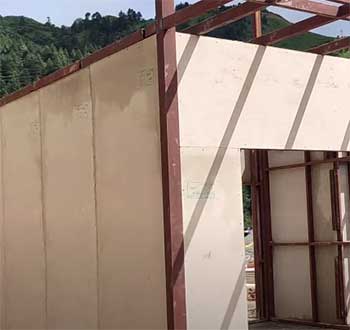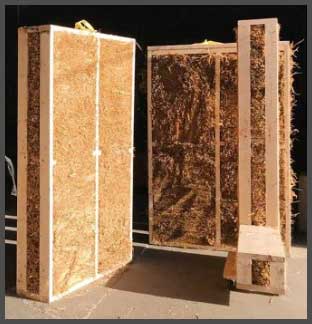Trusscore is a popular plastic wall panel system that aims to replace traditional drywall and provide increased strength, durability, and design flexibility. However, Trusscore is not the only option on the market for those looking for an alternative to drywall.
Several other materials and systems exist that offer similar benefits. This article will provide an in-depth look at the top Trusscore alternatives, examining the pros and cons of each to help you determine if one may be a better fit for your next project.
Alternatives To Trusscore
Here is a list of those equivalents:
- Plywood Wall Panels
- Fiberglass Reinforced Plastic (FRP) Panels
- Cement Board Panels
- Structural Insulated Panels (SIPs)
- Magnesium Oxide (MgO) Wall Panels
- Polyisocyanurate Rigid Foam Panels
- Straw Bale Wall Panels
- Cross-Laminated Timber (CLT)
- Microchipboard
- Cellular PVC Wall Panels
Let’s talk about them in detail.
Plywood Wall Panels

Plywood has been a construction staple for decades and offers some distinct advantages as an alternative to Trusscore panels.
Pros
- Cost – Plywood is generally cheaper than Trusscore panels.
- Availability – Easy to source at any hardware store or building supply retailer.
- Familiarity – Most construction workers are experienced at working with plywood.
- Strength – Plywood can provide ample strength for many applications.
- Customization – Plywood can be cut to any size and shape needed.
Cons
- Appearance – Does not offer the same sleek, modern aesthetic as Trusscore.
- Durability – Prone to scratches, dents, and water damage if not properly sealed and finished.
- Weight – Heavier than Trusscore, which adds to shipping and installation costs.
- Lack of insulation – No inherent insulating properties unlike Trusscore.
Plywood is best suited for commercial buildings or residential projects where budget is the primary concern. The lower cost and widespread familiarity with working with plywood are the main advantages.
However, for a more polished, designer look and added insulation, other alternatives on this list may be preferable.
Fiberglass Reinforced Plastic (FRP) Panels
FRP panels offer another cost-effective Trusscore alternative consisting of fiberglass set in plastic resin.
Pros
- Cost – Less expensive than Trusscore while still offering a sleek, uniform appearance.
- Durability – FRP resists scratches, dents, mold, and water damage.
- Custom sizes – FRP can be factory cut to custom lengths and dimensions.
- Easy installation – Lightweight panels are easy to cut, drill, and fasten to studs.
Cons
- Strength – Not as structurally strong as Trusscore or plywood.
- Insulation – No inherent insulation value.
- Fire rating – Typically Class C fire rating only.
- Resin odor – Some panels may emit unpleasant odors.
FRP panels are a great option for bathroom walls, commercial kitchens, laboratories, or other areas needing durable and water-resistant walls. The lower cost and sleek appearance make FRP a suitable Trusscore alternative for many applications.
Cement Board Panels
Cement board panels consist of cement sandwiched between fiberglass sheets. This results in a durable, moisture-resistant panel.
Pros

- Strength – Cement board is highly impact and damage resistant.
- Moisture resistance – Impervious to water and humidity.
- Fire resistance – Cement board is non-combustible.
- Mold resistance – Cement does not support mold growth.
Cons
- Weight – Heavier than Trusscore and difficult to install overhead.
- Appearance – Hard, industrial look, not sleek or designer-friendly.
- Cost – More expensive than plywood or FRP panels.
- Dust – Cutting generates fine cement dust.
Cement board panels are best for high-moisture areas like bathrooms, laundries, and basements where their waterproof properties are essential. The weight and industrial appearance make them less suitable for general wall applications where looks and easy installation are priorities.
Structural Insulated Panels (SIPs)
SIPs sandwich rigid foam insulation between two structural skins, typically oriented strand board (OSB). The result is a highly insulated, airtight panel.
Pros
- Insulation – Provides high R-value insulation for energy efficiency.
- Air sealing – Tight assembly reduces air leaks.
- Strength – Structural skins withstand impacts.
- Fast installation – Panels install quickly.
Cons
- Cost – Higher material cost than alternatives.
- Weight – Heavier panels require equipment to install.
- Skins prone to damage – OSB faces dent and scratch easily.
- Limited customization – Available in set panel sizes.
SIPs make an excellent Trusscore alternative for homeowners focused on energy efficiency, noise reduction, and fast installation times. The high cost makes SIPs less practical for very large projects where budget is critical.
SIPs need protection to avoid surface damage to the OSB faces.
Magnesium Oxide (MgO) Wall Panels
MgO panels consist of magnesium oxide bonded with water and pressure. This creates durable, fire-resistant panels.
Pros

- Fire rating – MgO carries top fire rating of A1, non-combustible.
- Strength – High impact resistance and tensile strength.
- Moisture resistance – Impervious to water and humidity.
- Mold resistance – MgO blocks mold growth.
Cons
- Cost – Among the more expensive alternative panels.
- Weight – Heavy panels require special handling.
- Dust – Cutting and drilling produce fine dust.
- Availability – Still an emerging material in some regions.
MgO panels offer fire-resistance unmatched by other alternatives, making them ideal for multi-family dwellings. Their strength and water-resistance suit them well to bathrooms, basements, and other high-moisture areas.
The high cost and limited availability mean MgO remains impractical for some mainstream applications currently.
Polyisocyanurate Rigid Foam Panels
Polyisocyanurate foam provides an ultra-lightweight but highly insulative wall panel option.
Pros
- Insulation value – Excellent R-value up to R-7 per inch of thickness.
- Cost – Relatively affordable.
- Lightweight – Easy to handle and install.
- Moisture resistance – Closed cell foam resists water.
Cons
- Strength – Low structural strength on its own. Needs additional frame backing.
- Fire rating – Typically Class B rating.
- Appearance – Plain foam face lacks aesthetic appeal.
- VOC Emissions – Some formulations may off-gas unpleasant VOCs.
Polyiso foam panels make a cost-effective insulation layer suitable for metal buildings and other commercial structures. The poor structural strength means polyiso panels require supplemental framing for most applications. The high insulating value remains the standout benefit.
Straw Bale Wall Panels
For eco-friendly building, straw bale walls offer a renewable and sustainable wall panel option.
Pros

- Renewable resource – Straw is fast-growing, annually renewable crop waste.
- Insulation – Bales provide thick insulation for energy savings.
- Cost – Straw bales are inexpensive and widely available.
- Breathability – Straw “breathes” well, allowing humidity passage.
Cons
- Appearance – Loose straw lacks refined, sleek aesthetic.
- Fire resistance – Bales are flammable and require fireproofing.
- Weight – Dense, heavy bales require equipment to install.
- Compression – Bales settle and compress over time.
For those committed to green and natural building, straw bale walls provide excellent insulating qualities. Their high flammability and loose, casual appearance limit straw bales’ suitability to low-key agricultural or residential projects focused on sustainability over style.
Cross-Laminated Timber (CLT)
CLT panels consist of layers of dimensioned lumber oriented at right angles and then glued under pressure to create a solid, structural panel.
Pros
- Strength – Excellent strength for wall, floor, and roof applications.
- Customization – Panels can be precut to required sizes.
- Appearance – Attractive wood grain finish.
- Sustainability – Made from renewable and responsibly sourced timber.
Cons
- Cost – More expensive than conventional building materials.
- Availability – Production centered in Europe currently, may have limited North American availability.
- Weight – Heavy panels require equipment for installation.
- Moisture exposure – Prone to swelling and deterioration if exposed to excessive moisture.
CLT provides the warmth and aesthetic of exposed wood walls with engineered strength and dimensional stability. It remains cost prohibitive for some residential applications but ideal for commercial and industrial buildings focused on sustainable materials.
Microchipboard
Microchipboards are manufactured from wood chips and fibers bonded together with resins into sheets. The tight bonding creates consistent, durable panels.
Pros
- Cost – Less expensive than plywood or OSB.
- Consistency – Uniform strength and appearance.
- Workability – Easy to cut and install using common tools.
- Availability – Readily available from panel product manufacturers.
Cons
- Strength – Lower lateral strength than plywood or OSB.
- Moisture resistance – Prone to swelling and deterioration from moisture exposure.
- Fire rating – Typically Class C, requiring additional layers for fire resistance.
Microchipboard provides a low-cost panel alternative well suited to housing and light commercial buildings. The ease of installation helps offset the lower strength limits. Best practices call for sealing and fireproofing when used as a wall panel.
Cellular PVC Wall Panels
Cellular PVC panels consist of rigid PVC foam sandwiched between layers of denser PVC outer skins.
Pros
- Moisture resistance – Impervious to water and humidity
- Workability – Easy to cut, drill, and fasten using basic tools
- Appearance – Glossy white finish
- Cost – Comparable to mid-range panel options
Cons
- Strength – Lower lateral strength than panels with structural skins
- Insulation value – Minimal inherent insulation
- Fire rating – Class C rating requires additional measures to improve
- Off-gassing – Some formulations may emit VOCs
PVC panels suit high-condensation areas like bathrooms and laundries where moisture resistance is critical. Limitations in strength and fire resistance make supplemental framing and layers prudent for broader wall applications.
Comparison Chart
| Material | Strength | Insulation | Moisture Resist. | Appearance |
|---|---|---|---|---|
| Trusscore Panels | High | Moderate | High | Sleek |
| Plywood | High | None | Moderate | Rustic |
| FRP Panels | Moderate | None | High | Sleek |
| Cement Board | High | None | High | Industrial |
| SIPs | High | High | Moderate | Varies |
| MgO Panels | High | None | High | Sleek |
| Polyiso Foam | Low | High | Moderate | Plain |
| Straw Bales | Low | High | Low | Rustic |
Frequently Asked Questions (FAQ)
The most similar alternatives to Trusscore panels are FRP, SIPs, and MgO panels. All provide high strength, moisture resistance, sleek aesthetics, and easy installation.
For many projects, Trusscore is worth the higher cost. The durability, strength, and design flexibility make Trusscore stand out from traditional drywall. It excels in high-moisture bathrooms and kitchens.
In the future, Trusscore and panels like it will likely replace drywall in an increasing number of buildings. However, drywall will remain the most common and cost-effective wall material for the foreseeable future.
Trusscore consists of extruded polypropylene plastic shaped into a honeycomb structure. The hollow grid design provides its impact resistance and strength while minimizing weight.
Closing Remarks
Trusscore offers a next-generation wall panel system but comes at a premium price point. For those seeking a cost-effective Trusscore alternative, materials like plywood, FRP, and polyiso foam panels offer useful options.
Homeowners focused on energy efficiency or eco-friendly building may prefer SIPs or straw bale walls respectively. There is no singular best option for every user and application.
Carefully examine the pros and cons of each material to determine which best aligns with your specific project requirements and budget constraints.
